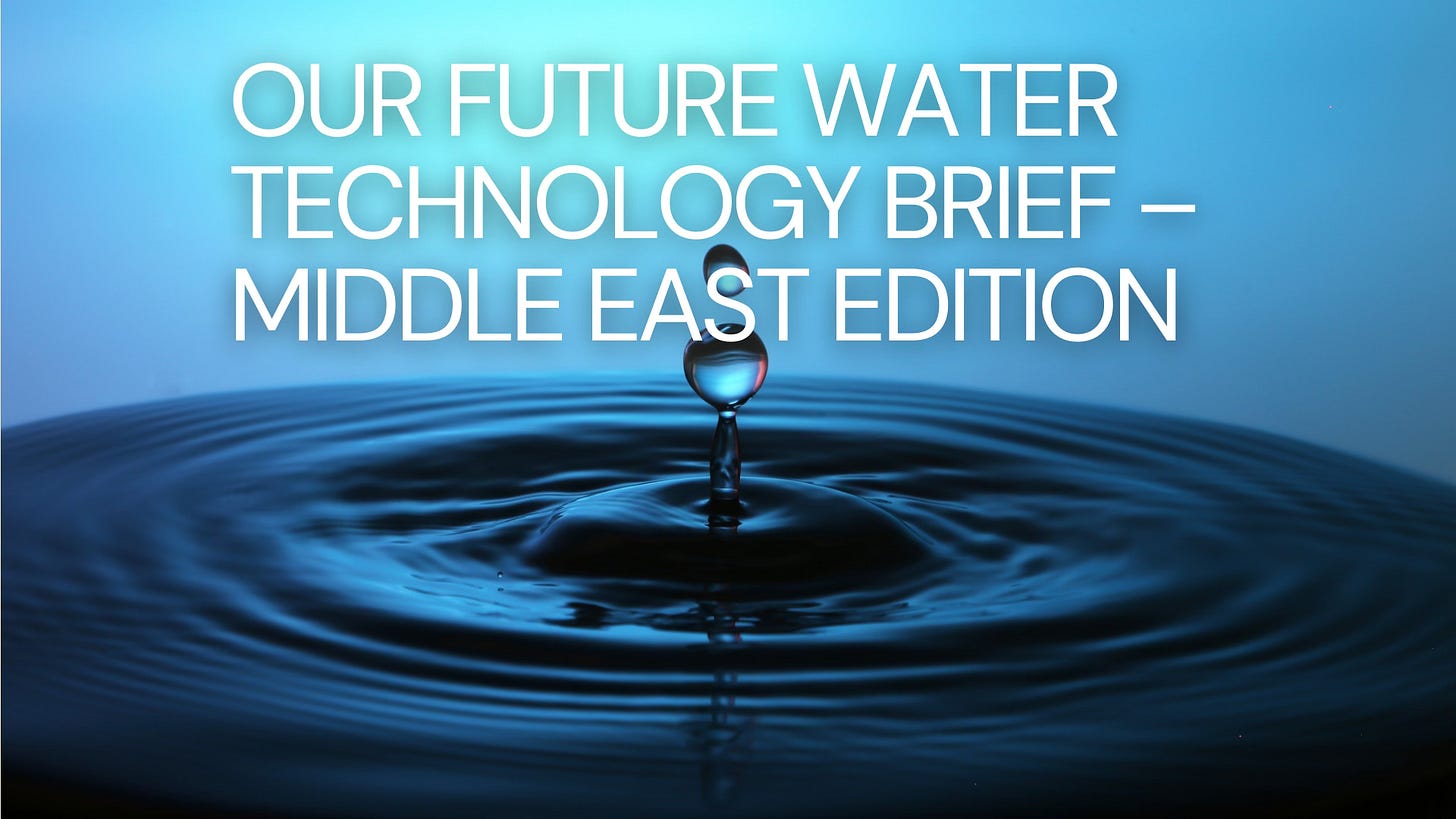Middle East Water Tech Brief – June 2025
Welcome to this month’s edition of the Middle East Water Tech Brief, your essential source for the latest water innovations, investments, and policies shaping the region’s water security.
Water security across the Middle East is entering a transformative era, driven by strategic investments, climate-resilient infrastructure, and smart water technologies.
In this edition of the Middle East Water Tech Brief, we track how Saudi Arabia, Bahrain, and the UAE are scaling water security through major infrastructure investments, AI-powered utility platforms, and innovative weather modification. From Qassim’s $293M pipeline expansion to Bahrain’s $2B grid upgrades and the UAE’s digital command center, the region is rapidly aligning water management with climate resilience, circularity, and national development strategies.
Key Developments
Saudi Arabia: $293 Million Investment in Qassim Region Water and Wastewater Infrastructure
What’s New?
The National Water Company has launched 16 water and wastewater projects in Qassim, Saudi Arabia, with a total investment exceeding $293 million. This includes the installation of over 645 km of sewerage networks and 579 km of water pipelines to enhance infrastructure and meet rising demand.
Why It Matters:
These infrastructure upgrades support Saudi Arabia’s Vision 2030 by improving service coverage, boosting environmental services, and ensuring water and sanitation sustainability for growing urban populations in Qassim.
What’s Next?
The projects will be implemented in phases with ongoing monitoring to align with the region’s development plans and population growth.
Saudi Arabia: Desalinated Water Supply Reaches 50% Milestone Under Vision 2030
What’s New?
Desalinated water now comprises 50% of Saudi Arabia’s total distributed water supply, up from 44% in 2022. This reflects a 31% surge in production. Simultaneously, water reuse rose by 12%, and agricultural groundwater use dropped by 7%.
Why It Matters:
The shift aligns with Vision 2030 goals to reduce reliance on non-renewable groundwater, increase water reuse, and support long-term water security through sustainable resource management.
What’s Next?
Further expansion of desalination infrastructure and recycling systems is expected, alongside irrigation efficiency improvements and industrial sector reforms to reduce natural water dependency.
Bahrain: $2 Billion Investment in Electricity and Water Infrastructure
What’s New?
Bahrain has announced a $2 billion investment in electricity and water works through 2026, including two major plants in Sitra and Hidd. The plan aims to address rising demand and strengthen the national grid, with BD400 million allocated for upgrades to cabling, substations, and service reliability.
Why It Matters:
These projects reflect Bahrain’s strategic push to improve energy-water integration and service quality while supporting sustainable development. The Sitra plant will deliver 1,200 MW of electricity and 30 million gallons of water daily, while the Hidd plant will contribute 60 million imperial gallons of water per day.
What’s Next?
The first stage of Sitra will come online in late 2028, with full operations by Q2 2029. The Hidd facility is expected to be fully operational by Q2 2028.
Technology Spotlight: Innovations in Water Management
AD.WE – AI-Powered Utilities Command Platform (Abu Dhabi, UAE)
What it Does:
Integrates real-time data across energy and water systems through an AI-powered platform to optimise resource management and support smart, centralised decision-making.
Why it Matters:
Supports the UAE’s utility efficiency and sustainability goals by unifying legacy data, enabling secure operations, and accelerating AI-driven energy and water innovation.
Impact:
Advances the UAE Energy Strategy 2050 by enhancing utility efficiency, enabling smart resource use, and paving the way for regional AI adoption in water-energy systems.
Cloud Seeding Enhancement Program – Saudi Arabia
What it Does:
Deploys advanced aircraft and global seeding technologies to enhance rainfall through targeted atmospheric interventions, aimed at increasing water availability in arid regions.
Why it Matters:
The initiative supports Saudi Arabia’s water security goals, aligning with the Middle East Green Initiative by addressing desertification and drought through sustainable weather modification.
Impact:
Since 2022, the program has executed 444 flights deploying 8,753 flares, generating an estimated 5 billion cubic millimeters of rainfall. New aircraft and technologies launched in 2024 aim to boost efficiency, reduce costs, and localize expertise.
Investment Tracker: Major Water Infrastructure Projects in 2025
Saudi Arabia
Al Suwayriqiyah and Al Aqiliyah Water Networks Project
$220M
Construction of pipelines, pump stations, and substations in Mahd governorate to expand water infrastructure and supply reliability.
Qatar
National Drainage and Flood Infrastructure Development
$22.3B
Implementation of sewage networks, flood prevention tunnels, and rainwater drainage systems as part of Ashghal’s five-year infrastructure strategy.
United Arab Emirates (Dubai)
Dubai South Stormwater Drainage System – Tasreef Phase
$41M
Development of advanced stormwater drainage infrastructure connecting Dubai South to Dubai Municipality’s deep tunnel network.
Upcoming Event
Global Water Expo 2025 | September 2–4, 2025 – Riyadh Front Exhibition & Conference Center
Focus on desalination, water treatment, and integrated infrastructure solutions
Speakers include senior officials, utility executives, and global technology providers
Key platform for shaping Saudi Arabia’s $80 billion water sector investment strategy
Want More? Unlock Expert-Only Insights
The Middle East Water Tech Brief – Premium Edition offers exclusive insights into AI-powered water management, digital transformation in utilities, and climate-resilient infrastructure across Saudi Arabia, the UAE, and the wider Gulf region.
Why It Matters
AI is no longer theoretical—it’s embedded in utility operations across the Middle East. From TAQA’s AI-integrated water recycling systems to DEWA’s GenAI-native utility roadmap, the region is leading a shift toward smart water infrastructure and data-driven utility governance.
What You Will Discover
How cloud-based platforms like Microsoft Azure are modernizing legacy water infrastructure
Why digital twins and predictive analytics are transforming water resilience strategies
How AI deployments in Gulf countries are shaping water diplomacy and regional influence
What’s next in the race to develop the first fully AI-native water utility globally
Why Subscribe?
Join those shaping the future of water—policy architects, tech leaders, and financiers who rely on Premium Edition for trusted, strategic foresight. Get the edge you need in a region driving global water innovation.
Keep reading with a 7-day free trial
Subscribe to Middle East Water Tech Brief to keep reading this post and get 7 days of free access to the full post archives.


